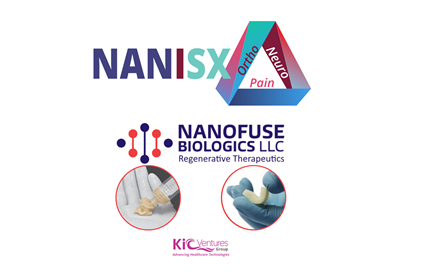ZFUZE Shows 91.4% Fusion Rates at 8 Months
AUSTIN, Texas, Sept. 08, 2022 (GLOBE NEWSWIRE) — DiFusion, Inc., an Austin, Texas-based leader in biomaterial technological innovation focused on introducing bioactive polymers in spinal and orthopedic surgery, today announced the results of the study “Can a bioactive interbody device reduce the time horizon for Spinal fusions?” that validates ZFUZE as the first homogenous new biomaterial introduced in more than 20 years.
Beyond titanium and PEEK, there has been little industry innovation in recent years, according to Derrick Johns, the CEO and Founder of DiFusion Technologies — a company dedicated to engineering and bringing to market a suite of patented immunomodulatory, tissue regenerating and antimicrobial polymers — who said, “ZFUZE overcomes the shortcomings of titanium and PEEK such as cage subsidence and fibrous tissue encapsulation.
“The industry has taken shortcuts with regard to new biomaterials. To date, they have merely applied surface coatings to PEEK and altered the surface topography of titanium. Large device companies are hesitant and may not be equipped to take on new biomaterial projects that take years to develop and test with no guarantee of success.” Johns continued, “ZFUZE is a long-overdue innovation.”
The ZFUZE retrospective study was conducted by Paul Kraemer, MD, at the Indiana Spine Group and consisted of 41 patients who underwent TLIF [define] single and double level lumbar interbody fusions. Radiographic CT analysis conducted by third-party Medical Metrics Inc on ZFUZE implants showed a 91.4% fusion rate at 8 months. “Maybe the most important thing about the study was there were no exclusion criteria,” Dr. Kraemer said. “It included anyone who I felt had surgical pathology best amenable to a TLIF, which is my most common fusion technique. There were old people, patients with scoliosis and osteoporosis, lots of adjacent segment pathology and more. It’s a realistic view of a modern surgical practice — and the material acquitted itself very well. It fused and fused quickly. Importantly, it fused like we thought it would, with real bone seen on CT directly adjacent to the implant, including through the cage. Even better, there was no cage subsidence and no fibrous encapsulation. It’s a testament to the material acting in vivo exactly as we expected from our in vitro and animal studies.”
Peter Whang, MD, associate professor at Yale University in New Haven, Conn., summarized: “ZFUZE is truly an example of differentiated homogenous new material technology that bridges the gap between conventional PEEK and titanium. Specifically, ZFUZE shares the same advantages of standard PEEK relative to titanium in that it facilitates visualization of bone formation across the disc space, exhibits the same modulus of elasticity which reduces the risk of subsidence and does not produce metal wear debris. However, it is not associated with the formation of a fibrous capsule and promotes osseointegration, like titanium. There is ample data from basic science investigations, animal studies and now extensive clinical experience showing that this novel biomaterial does not give rise to chronic inflammatory changes which may limit the utility of PEEK and titanium. I am extremely excited about the potential of ZFUZE to bring about earlier and more robust bone formation for my fusion cases.”
The ZFUZE research and development process has involved laboratory, animal and human studies. These studies include:
Osteoimmunology testing i, conducted by the McGowan Institute for Regenerative Medicine at the University of Pittsburgh. This testing found a decrease in chronic inflammation compared to titanium and PEEK and a 700 percent increase in osteoblast proliferation versus titanium and PEEK. There was also pro-reparative immunomodulation, as ZFUZE increases Interleukin-10 and Interleukin-12. In addition, ZFUZE demonstrated higher levels of rhBMP upregulation versus titanium and PEEK. “We have tested over 300 materials here at McGowan and have never observed positive immunomodulation toward early healing like we see in ZFUZE,” said Stephen Badylak, MD, DVM, PhD.
Animal studies ii, by Boyle Cheng, PhD, at Meadville, Pa.-based Alleghany University, using sheep and rabbits, found statistically significant reductions in proinflammatory cytokines Interleukin-1 beta and Interleukin-6 at six months versus titanium and PEEK, along with successful fusion.
Human studies iii, led by Paul Kraemer, MD, of Indiana Spine Group, were conducted retrospectively with 41 patients. No patients were excluded, as is typically the case in other retrospective studies; in fact, smokers, osteopenic and diabetic patients were all included. The average patient age was 67. Medical Metrics LLC performed third-party radiographic fusion analysis via CT scan for 91.4% fusion rates at an early 8-month timepoint.
About DiFusion
By definition, biomaterials are foreign bodies. Historically, their design has largely been based upon mechanical and physical properties, and bio-inertness was a desirable characteristic. Today, as the adaptability of immune cells and the role that biomaterials play on immune-mediated tissue responses become better understood, there is a shift toward designing materials that can proactively modulate the immune system.
Located in Austin, Texas, DiFusion was founded in 2009 and is dedicated to engineering and bringing to market a suite of patented Immunomodulatory, Tissue Regenerating and Antimicrobial Polymers. DiFusion has assembled a team of leading clinical and research experts on their Scientific Advisory Board.
i McGowan Institute for Regenerative Medicine – UPITT
ii Allegheny University – Center for Neuroscience: Un-plated Cervical Sheep Fusion Study Cage Study;
DaVinci Labs: Rabbit Femur Critical Defect Study
iii Indiana Spine Group and Medical Metrics LLC – Third Party Radiographic Fusion Analysis
This content was issued through the press release distribution service at Newswire.com.








